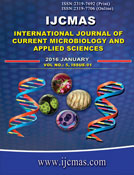


 National Academy of Agricultural Sciences (NAAS)
National Academy of Agricultural Sciences (NAAS)

|
PRINT ISSN : 2319-7692
Online ISSN : 2319-7706 Issues : 12 per year Publisher : Excellent Publishers Email : editorijcmas@gmail.com / submit@ijcmas.com Editor-in-chief: Dr.M.Prakash Index Copernicus ICV 2018: 95.39 NAAS RATING 2020: 5.38 |
Salt tolerant and chromium resistant fungal strains were isolated from two different sites i.e. psychrotolerant fungus PLF1, was isolated from Pangong lake of Laddakh, India and mesophilic strain PMS2, was isolated from garden soil. Present study was carried out on interaction of Penicillium sp. with chromium and NaCl and reports ability of Penicillium sp. to bind with chromium and NaCl in aqueous solution. Biosorption of the chromium ion Cr(VI) onto the cell surface of Penicillium fungal species in aerobic condition was also investigated. Results displayed 42.85 and 40.38% inhibition of mycelial growth in presence of 10% NaCl and 100 ppm concentration of Cr (VI), whereas 63.15 and 60.65% inhibition of mycelial growth was observed in absence of NaCl and 100 ppm concentration of Cr (VI) in PLF1 and PMS2 fungal isolates respectively on 10 th day of incubation. It is demonstrated in the present study that NaCl reduced the extent of Cr biosorption and promote the fungal strains of Penicillium for better growth. FTIR spectrum was used to evaluate the membrane surface binding of chromium and NaCl by fungal strains of Penicillium.SEM was used to obtain the morphological as well as structural characterization of fungal pellets. The present finding suggests that NaCl might reduce the toxicity of hexavalent chromium in Penicillium sp. and may be used as a potential organism for remediation of chromium in high salinity environments.
 |
 |
 |
 |
 |